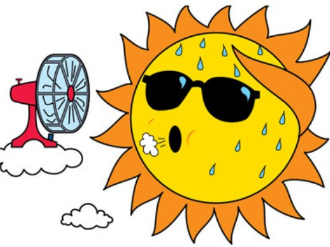High temperatures are heading this way and can prove dangerous for mankind and metal alike. During the next few days tristate motorists will experience excessive heat coupled with high humidity, producing triple digit heat indices with temperatures reaching 93 degrees on Thursday, according to the National Weather Service.
When outside temperatures are 80 to 100 degrees Fahrenheit, as forecast for the days ahead, the interior of cars parked in direct sunlight can easily reach between 180 and 200 degrees Fahrenheit in a matter of minutes. This is especially dangerous for many, including: children five and younger, adults over 65, pregnant or nursing women, and persons with disabilities or pre-existing medical conditions, putting them at risk of heat stroke and heat prostration.

It only takes just 15 minutes for a child left inside a hot vehicle to suffer life-threatening brain, liver and kidney injuries.
AAA Urges Motorists To ACT:
• A—Avoid heatstroke by never leaving a child in the car alone, not even for a minute.
• C—Create electronic reminders or put something in the backseat you need when exiting the car – for example, a cell phone, purse, wallet, briefcase or shoes. Always lock your car and never leave car keys or car remote where children can get to them.
• T—Take action and immediately call 9-1-1- if you notice a child unattended in a car.
“Extreme temperatures pose a risk to drivers, their passengers and vehicles they drive, especially if their cars aren’t ready for the extreme heat,” says Cheryl Parker, AAA spokeswoman. “Many summertime breakdowns could be prevented with proper maintenance. That’s why it’s even more critical to ensure your vehicle is properly prepared to meet the summer heat.”
Preventive Summer Vehicle Maintenance Tips
Before hitting the road:
• Heat kills batteries. Make sure you have a strong battery that is up to the challenge by having your battery tested.
• Check all fluids, including the coolant level in the overflow tank and top off, as needed. If the engine is cool, check the level in the radiator as well. Never remove the radiator cap when the engine is hot. You can be seriously scalded.
• Inspect your brakes, shocks, filters, and pump.
• Motorists should have the cooling system flushed and new coolant installed when recommended by the vehicle manufacturer. Depending on the type of coolant used, this is typically necessary every two to five years.
• Keep your tires at normal pressure. Soft tires generate heat, which can lead to a blowout.
Once on the road:
• Keep an eye on your gas, oil and engine temperature gauges.
• In heavy traffic during a heat wave, don’t tailgate the car ahead. It can stress a car’s cooling system when it sucks in hot exhaust fumes.
• Should you overheat, pull off the road, shut the engine off immediately and allow the vehicle to cool.
“For safety’s sake, every driver should have a well-stocked emergency kit that includes a mobile phone and car charger; a flashlight with extra batteries; a first-aid kit; drinking water; extra snacks/food for your travelers and any pets; battery booster cables; and emergency flares or reflectors,” added Parker.
From AAA
















